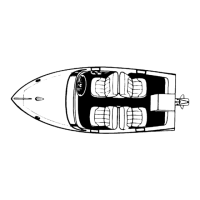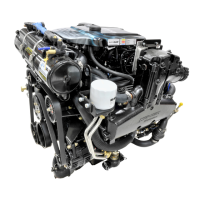90-823225--1 10965E-86 - ELECTRONIC FUEL INJECTION (MULTI-PORT AND THROTTLE BODY)
Discrete Input Circuit Check (Power Reduction Mode) (Non-Scan)
(1 of 2)
TO SYSTEM
RELAY TERM
“87”
TO BUZZER
TO IGN
TO AUDIO
WARNING
SWITCHES
TO TACH
J1-6
931 BRN
TAN/
BLU
PPL
BLU/
TAN
GRY
TO
IGN
COIL
D
C
B
A
PUR
121 WHT
121 TAN
TO BUZZER
(COOLANT OVERTEMP)
TO BUZZER
(AUDIO WARNING SWITCHES)
FROM AUDIO WARNING
SWITCHES
3 PNK
CIRCUIT DESCRIPTION:
Several discrete switch inputs are utilized by the fuel
injection system to identify abnormal conditions that
may affect engine operation. A pull-up switch is cur-
rently used in conjunction with the ECM to detect criti-
cal conditions to engine operation.
If a switch changes states from its normal at-rest
position, that is normally open to closed, the ECM
senses a change in voltage and responds by entering
power reduction mode. (And activating the audio
warning system.)
NOTE: Power reduction mode is not used 1997 and
later models.
This engine protection feature allows the driver full
engine power up to 2800 RPM, but disables four fuel
injectors above 2800 RPM until the engine RPM
drops to 1200 RPM.
This feature allows the operator a comfortable ma-
neuvering speed while removing the possibility of
high RPM engine operation until the problem is cor-
rected.
TEST DESCRIPTION:
NOTE: Refer to Section 4C to test transmission tem-
perature switch.
1. This step checks if wiring from the engine
switches to the ECM is not shorted to ground.
2. This step ensures that the discrete switches are
functioning properly by changing state. (I/O oil
level, transmission temperature will not change
state.)
DIAGNOSTIC AIDS:
• Check engine oil and I/O fluid levels, transmis-
sion fluid, overheat.
• If above diagnostics are performed and no
change in performance is made, refer to “Trou-
bleshooting.”
An intermittent problem may be caused by a poor or
corroded connection, rubbed through wire connec-
tion, or a wire that is broken inside the insulation.

